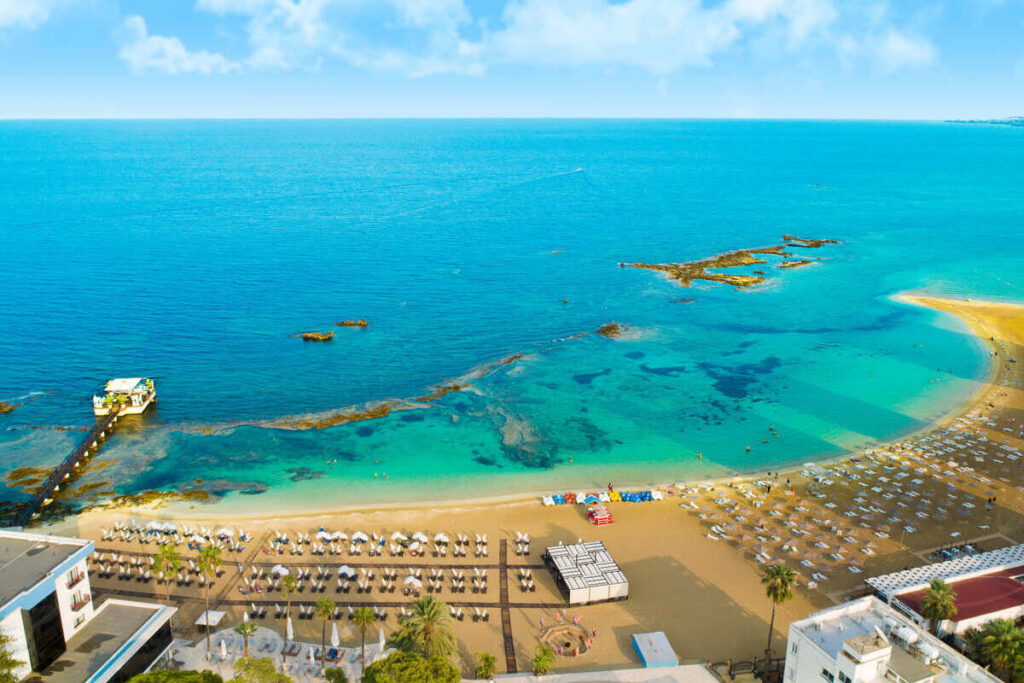No products in the cart.
Travel Guide
The Trendy European Summer Hotspot Very Few Americans Know About
Last Updated
Europe’s borders are fully open, and all pandemic-related restrictions have been lifted, causing travel demand to skyrocket in response, but while a majority of tourists will be fighting for a spot in the sun in Ibiza or Santorini, very few have set their hearts on this beautiful summer hotspot — especially Americans.

Cyprus is one of the trendiest Mediterranean destinations right now.
An island nation located in the basin’s far East, a stone’s throw away from Turkey, it is rising further in popularity due to its burgeoning resort scene and a pristine coastline lapped by azure waters.
But there is more to Cyprus than meets the eye, as it houses not one but two countries, the Northernmost of which doesn’t even technically exist. Sounds confusing?
Allow us to explain:
The Complex History Of North Cyprus

Cyprus’ recent History is one of conflict.
While we won’t bore you with detail, one thing you should know is that the island is split in two between the internationally-recognized Republic of Cyprus, and a breakaway state, the Turkish Republic of Northern Cyprus, which occupies a third of the territory.
While the Republic, lying to the South of a United Nations Buffer Zone, is a member of the European Union and home to Greek-speaking Cypriots, a majority of Turkish-speaking Cypriots, as well as Turks who have emigrated from mainland Turkey, live in the unrecognized, heavily-embargoed North.
Top 5 Travel Insurance Plans For 2023 Starting At $10 Per Week

Cyprus has been at the heart of a centuries-old conflict between Greece and Turkey, aggravated since Turkish forces invaded and occupied the Northern portion of Cyprus in the seventies, and the current status quo is often considered an unsolvable quandary in geopolitics.
Despite continued militarization on the island since the invasion, particularly along border zones, Cyprus is considered safe to visit, and both Southern Cypriots and Northern Cypriots live peacefully on their respective sides of the dividing line in spite of a lack of integration.
Cyprus is, after all, a super trendy Mediterranean spot, hosting millions of guests every year.

Interestingly, a majority of tourists only ever visit the Greek-speaking South, either rapidly glossing over or skipping the North altogether due to its reputation of being underdeveloped and simply ‘not worth the hassle’.
The truth of the matter is these widely-disseminated misconceptions could not be further from the truth.
Is This Southern Europe’s Most Underrated Destination?

The North of Cyprus is perhaps the island’s most fascinating region.
The de facto state extends from the tip of the Karpass Peninsula, the Northeasternmost point of Cyprus, where some of the best beaches and marine parks are located, to Cape Kormakitis on the Northwestern coast.
Aside from a handful of exclaves, the border with the South runs along the heart of Nicosia, the island’s capital and a city claimed by both the Turkish Cypriot administration and the Greeks.

North Nicosia is jam-packed with tourist attractions, such as the Selimiye Mosque, the largest and oldest Gothic structure in Cyprus that used to be a church, to the 16th-century Büyük Han caravansarai, and an Ottoman bazaar bustling with trade.
Beyond Nicosia, adventurous tourists are drawn to the city of Kyrenia (called Girne in Turkish), straddling the North Cypriot coast. With its heavily fortified harbor, medieval castle, and cobblestone streets edged by traditional Greek-style whitewashed houses, it is really the stuff of fairy tales.
Kyrenia is also within short driving distance of gorgeous coastal spots, most notably the Alagadi Turtle Beach, highly sought-after by wildlife spotters, and Diana Beach, a tiny, secluded bay bounded by the azure waters of the East Mediterranean.
Outside the major urban settlements, the breakaway North has retained the postcard-ready 13th-century Bellapais Monastery, nestled between the lush green mountains, only 3 miles southeast of Kyrenia.
The hilltop ruined Saint Hilarion Castle, set against a dramatic rugged landscape, is yet another gem worth exploring.
Also not to be missed: the archaeological complexes of Soli and Salami, comprising the remnants of two ancient Greek cities which still feature an amphitheater, a colonnaded agora, and remarkably well-preserved mosaics.

If it’s some beach fun you’re after, the Karpass Peninsula is where you should be headed. Expect to find beach clubs, an up-and-coming resort scene with affordable overnight stays, and less crowds in comparison to South Cyprus’ resort town of Ayia Napa.
In the Famagusta Province, which took the brunt of the conflict in the seventies, dark tourism is blooming, particularly in the Ghost Town of Varosha, cleared in the seventies following the invasion, and the shelled city of Famagusta itself.
How To Safely Visit North Cyprus

Some important info you should know ahead of visiting North Cyprus:
Despite not being recognized as a country, it issues passports*, it has a national flag, a different language (instead of Greek, Turkish is the most widely-spoken language), currency (the Turkish Lira is in use), and of course, it’s established border posts with the South and its own police force.
*International recognition of travel documents issued by the Turkish Republic of Northern Cyprus is limited
The depreciated Turkish Lira is partly the reason why Turkey is such a popular budget destination for American travelers, and the fact that the North of Cyprus has adopted it means it is much cheaper than the Euroized South.

According to a recent report published by North Cyprus International, prices are on average 25% lower in the North, with most of the food being locally produced and hotel fares being similar to those in the sister nation of Turkey.
The cost of living in North Nicosia and Kyrenia may be higher, as they are important tourism and trading hubs, but Northern Cypriot cities remain incredibly cheap by European standards.
Careful Not To Be Banned From Entering The South

The best way to get to North Cyprus is flying to the South first.
You can only fly to North Cyprus directly via Turkey, as all other countries have suspended flights to North Nicosia since the conflict erupted all those decades ago.
There is a catch, though: arriving directly in the North, you will be unable to cross to the South afterward, as the Republic’s authorities will deem you have entered Cypriot territory illegally.
In order to avoid problems, it’s best to land first in Larnaca, the main international airport serving the Republic of Cyprus, and get a shuttle bus to South Nicosia. Once in the capital city, you can cross the border at one of the many checkpoints splitting Nicosia in half.

The busiest of them, the one on Ledra Street, Nicosia’s main shopping avenue, is the preferred crossing point for tourists.
You will have no issue going back and forth between the Republic of Cyprus, and the Turkish Republic of Northern Cyprus, as long as you are stamped in the Republic of Cyprus (the Greek South) first.
The easiest way to travel around North Cyprus is driving, as public transportation options are limited, and some intercity buses do not run on a fixed schedule, departing only when full. There are no trains in the island of Cyprus.
Luckily, regular bus services link major cities like Nicosia (North) and Kyrenia/Girne.
Cyprus Is A Level 1 Destination

Cyprus is perfectly safe for tourists, with the State Department listing it as a Level 1 destination in spite of the unsolved dispute.
As long as you do not attempt to enter the Buffer Zone or militarized areas, you will have no issue exploring this fascinating island, both North and South.
Learn more about Cyprus here.
Traveler Alert: Don’t Forget Travel Insurance For Your Next Trip!
↓ Join Our Community ↓
The Travel Off Path Community FB group has all the latest reopening news, conversations, and Q&A’s happening daily!

SUBSCRIBE TO OUR LATEST POSTS
Enter your email address to subscribe to Travel Off Path’s latest breaking travel news, straight to your inbox.
This article originally appeared on TravelOffPath.com

